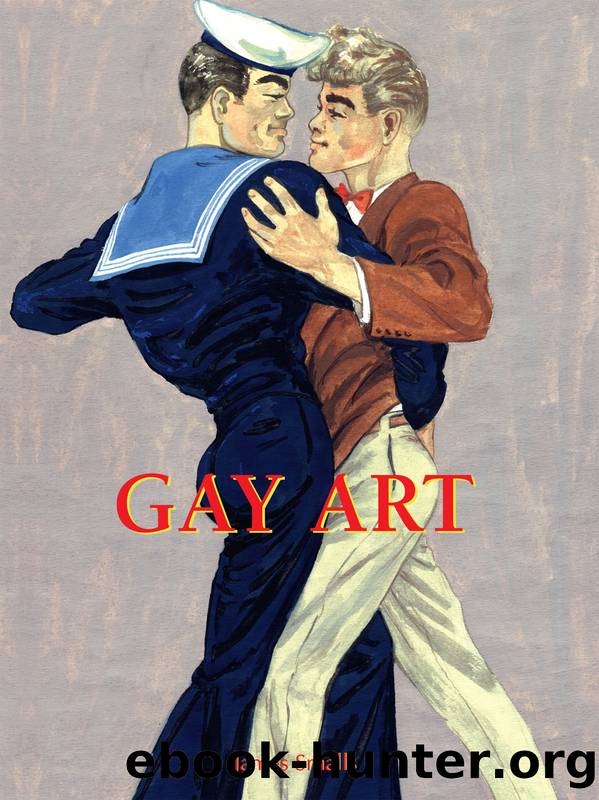Gay Art by James Smalls

Author:James Smalls [Smalls, James]
Language: eng
Format: epub
ISBN: 9781785259340
Publisher: Parkstone International
113. Anton Mengs, Jupiter and Ganymede, 1758-1759. Fresco.
Galleria Nazionale dâArte Antica, Palazzo Barberini-Corsini, Rome.
Libertines and Libertinism
Libertinism flourished in sixteenth and seventeenth-century France and England, encouraged by the rise in atheism in France and by the restoration of the English monarchy in 1660. This restoration ushered in an era of materialism and consumption that contrasted strongly with the Puritan rule of Oliver Cromwell.
The concept of libertinism developed in sixteenth-century France and was originally used to describe religious non-conformism but later came to encompass a range of social misconduct, especially sexual misconduct. Generally speaking, the term relates to the idea of personal freedom and to the development of modern concepts of the self. Libertines were represented as rakes who corrupted married women and ruined virgins (Vincent Quinn, âLibertines and Libertinism,â in Haggerty, pp.540-1). Libertinism was also linked to fashion, the stage, and the rise of pornography. It emphasised consumption, whether of risqué plays, erotic prints, or expensive clothes. Because of its association with the theatre, libertinism carried with it playful, performative qualities (Quinn, p.540).
Libertines were nonconformists. They usually sought out scandal, showing their dissatisfaction with existing cultural norms. The blasphemy and sexual freedom associated with libertinism was a challenge to a restrictive society that emphasised class obligations over individual pleasures. Libertines sought self-gratification and often indulged in sexual pleasure as a way to combat social conventions and traditional morality. They asserted an individualâs right to forge a unique identity centred on personal inclinations. This attempt to forge a unique identity based on oneâs sexual preference connects libertinism to the evolution of modern homosexuality (Quinn, p.540). Although the majority of libertines were heterosexual or bisexual, homosexuals and homosexuality were very much part of libertinism. For the true libertine, however, these divisions of sexual preference were irrelevant, for their actions often originated from a desire to repudiate middle-class respectability. However, some did have strong ties to homosexual subcultures.
Libertinism is class-biased, available only to a small minority who relied upon their class position and their gender. Libertines tended to be aristocratic men as opposed to the working-class women who were usually their victims. Even the language used in libertine texts is often misogynistic (Quinn, p.540). Despite the gender bias, there were female libertines among the upper classes. Libertinism reached an end in the late eighteenth century with the notorious antics of perhaps the most famous libertine of them all â the Marquis de Sade (1740-1814). De Sade produced four major novels, many short stories, dialogues, plays, pamphlets, letters, journals, and a number of still unpublished works (Stephanie Hammer, âSade, Donatien-Alphonse-François, Marquis de,â in Haggerty, pp.761-2). De Sade was condemned by both royal and revolutionary authorities. However, his writing is now recognised as crucial to the development of erotic discourse. He invented a philosophical system based on perversion. He carried ideas of the Anglo-European Enlightenment to their ultimate extreme.
As with his contemporaries Diderot and Voltaire, de Sade was profoundly anti-Christian. His writings functioned as exhaustive catalogues of sexual deviance. In his fictional worlds, virtue is always
Download
This site does not store any files on its server. We only index and link to content provided by other sites. Please contact the content providers to delete copyright contents if any and email us, we'll remove relevant links or contents immediately.
Shoot Sexy by Ryan Armbrust(17158)
Portrait Mastery in Black & White: Learn the Signature Style of a Legendary Photographer by Tim Kelly(16497)
Adobe Camera Raw For Digital Photographers Only by Rob Sheppard(16404)
Photographically Speaking: A Deeper Look at Creating Stronger Images (Eva Spring's Library) by David duChemin(16172)
Bombshells: Glamour Girls of a Lifetime by Sullivan Steve(13125)
Art Nude Photography Explained: How to Photograph and Understand Great Art Nude Images by Simon Walden(12367)
Perfect Rhythm by Jae(4633)
Pillow Thoughts by Courtney Peppernell(3431)
The Book of Joy by Dalai Lama(3245)
Good by S. Walden(2926)
The Pixar Touch by David A. Price(2749)
Fantastic Beasts: The Crimes of Grindelwald by J. K. Rowling(2554)
A Dictionary of Sociology by Unknown(2524)
Humans of New York by Brandon Stanton(2385)
Read This If You Want to Take Great Photographs by Carroll Henry(2312)
Stacked Decks by The Rotenberg Collection(2288)
On Photography by Susan Sontag(2142)
Photographic Guide to the Birds of Indonesia by Strange Morten;(2098)
Insomniac City by Bill Hayes(2093)
